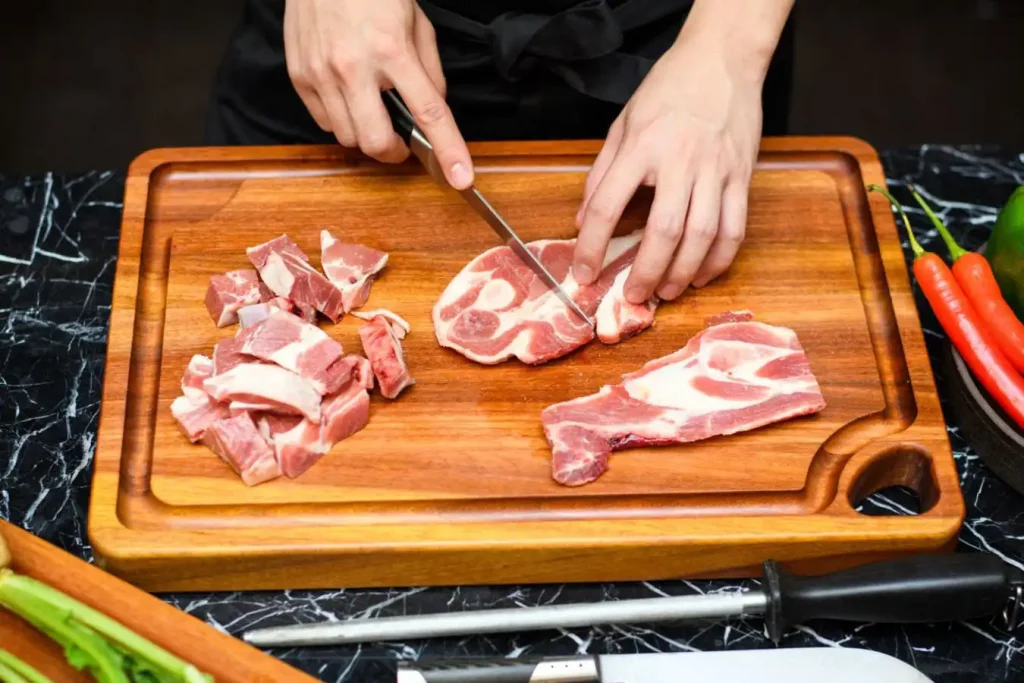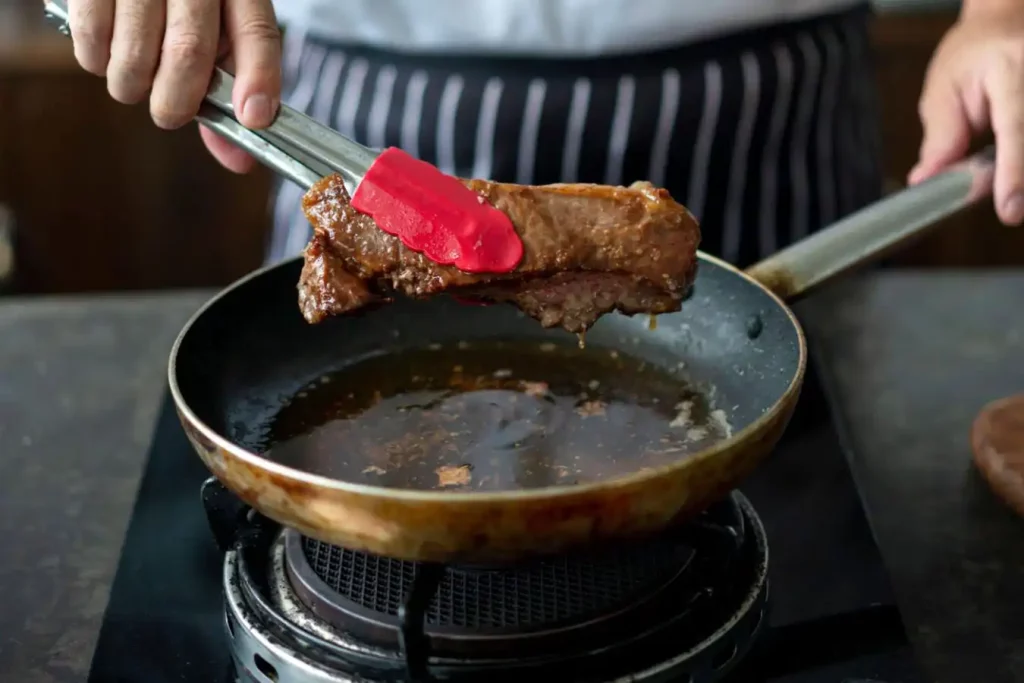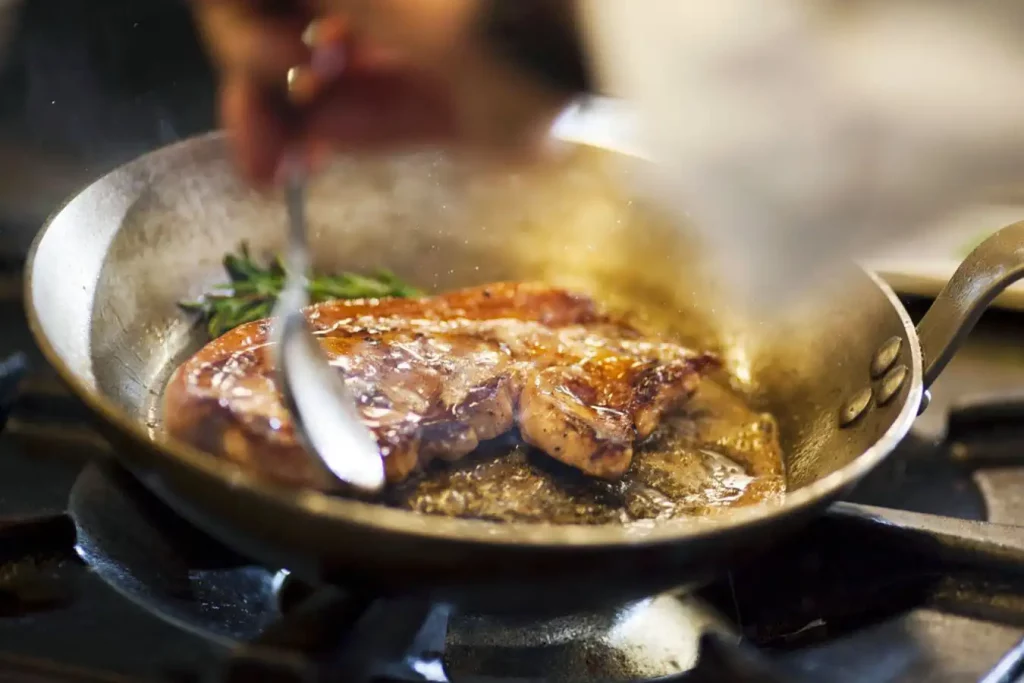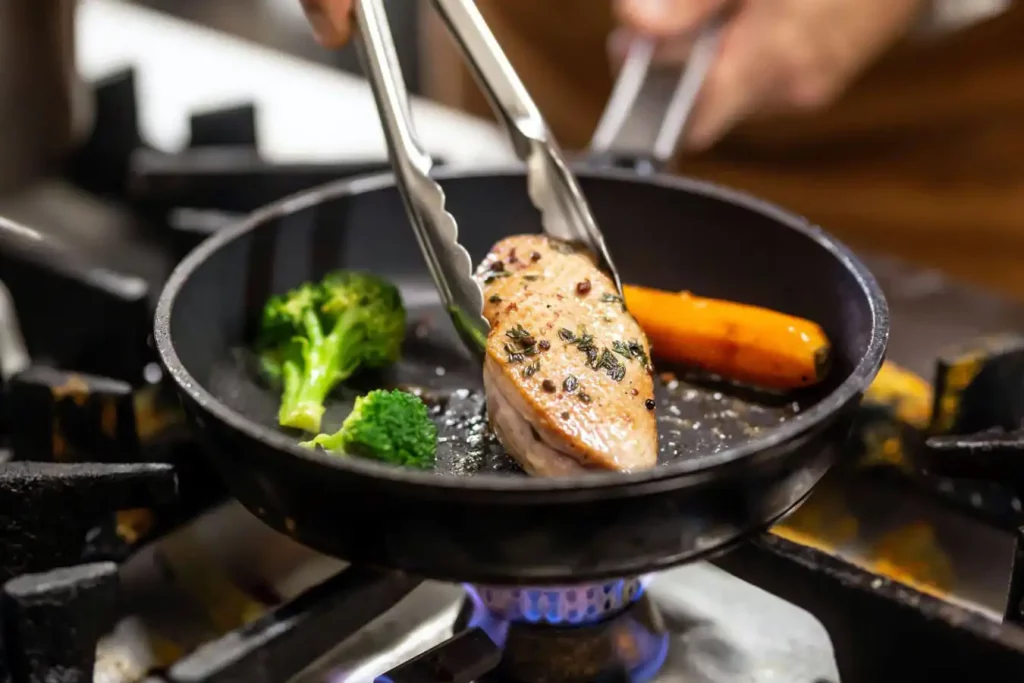Looking to learn “how to make steak in a cast iron skillet”?
This article will take you through the process, serving up sizzling steakhouse delights right in your home kitchen.
Feeling the heat already?
Well, buckle up for a culinary journey that will leave you equipped to cook restaurant-quality steak.
Ready for a mouth-watering adventure?
Let's turn up the heat and get cooking!
Choosing the Right Steak
The first step in our steak-cooking journey involves making a crucial decision: choosing the right cut of steak. The cut you select can significantly influence the texture, flavor, and cooking time of your steak. So, how do you make the right choice? Let's explore.

Different Types of Steaks and Their Characteristics
There's a world of variety when it comes to steak cuts, each with its unique attributes. Some cuts are lean and tender, perfect for quick cooking methods like pan-searing. On the other hand, some cuts are rich in connective tissues and benefit from longer cooking times.
- Filet Mignon: Lean, tender, and delicate. Its mild flavor makes it an excellent candidate for sauces or rubs.
- Ribeye: Rich, flavorful, and juicy, thanks to its high marbling. It's the preferred choice for many steak aficionados.
- Sirloin: A balance of tenderness and flavor, it's a versatile cut that works well with various cooking methods.
- T-Bone: Offers the best of both worlds, with a piece of tenderloin and strip in one cut.
The list goes on, with cuts like Porterhouse, Flank, and Skirt each offering a unique steak experience. The key is to understand each cut's characteristics and select the one that best suits your taste and cooking style.
Tips for Buying a High-Quality Steak
Now that you have a basic understanding of different steak cuts, let's focus on choosing the best quality steak for your cast iron skillet feast. Here are some tips to guide your purchase:
- Look for Marbling: Marbling refers to the thin veins of fat that run throughout the meat. A well-marbled steak promises a juicy and flavorful outcome, so don't shy away from the fat!
- Thickness Matters: Opt for a steak that's at least 1-inch thick. Anything less may overcook before achieving the desired crust.
- Fresh is Best: If possible, buy fresh steak instead of frozen. The texture and flavor are usually superior.
- Trust Your Butcher: When in doubt, consult your butcher. They can guide you to the best cuts and even provide cooking tips!
Remember, choosing a high-quality steak is half the battle won. In the upcoming section, we'll delve into preparing and cooking your steak to perfection in a cast iron skillet. Stay tuned, fellow foodies!
Preparing the Steak
Now that we have our perfect steak, it's time to prepare it for the cast iron skillet. Preparing your steak is a critical step in the cooking process. It's where we can add additional flavors and ensure our steak cooks evenly. So, let's dive into some key steps.
Importance of Room Temperature Steaks
Have you ever wondered why some steaks turn out perfectly seared outside yet cold and nearly raw inside? This could be due to cooking a steak straight out of the fridge. Cold meat tends to cook unevenly, which might lead to a less-than-ideal result.
So, here's a pro-tip: allow your steak to sit at room temperature for about 20 to 30 minutes before cooking. This simple step helps the steak to cook more evenly, ensuring a beautifully seared crust and a correctly cooked interior. In my experience, this small wait can make a huge difference in your steak-cooking venture.

Seasoning Your Steak for Maximum Flavor
Next up, we have the crucial stage of seasoning. Seasoning your steak is more than just sprinkling salt and pepper. It's an opportunity to enhance the steak's natural flavors.
A basic, yet effective approach is using coarse salt and freshly ground black pepper. Be generous with your seasoning, remember that some of it will stick to the pan. For an extra punch, consider adding crushed garlic cloves, rosemary, or thyme to the skillet during cooking. These add a subtle depth of flavor that complements the rich taste of the steak.
Preparing Your Cast Iron Skillet
Moving on, let's focus on your trusty tool: the cast iron skillet. Preparing the skillet correctly can influence your steak's searing and overall cooking experience.
The Importance of Preheating the Skillet
Cast iron is a champion at retaining heat, but it needs a little time to reach its full potential. Preheating your skillet before cooking the steak ensures that the meat sears quickly, creating that desirable crust.
So, how do you preheat your skillet? Simply place it over medium-high heat for about 5 minutes before you add your steak. The skillet should be hot but not smoking excessively. Remember, patience is the key here!
Choosing the Right Oil for High-Heat Cooking
The choice of oil can significantly influence the outcome of your steak. As we're cooking at high temperatures, it's important to use an oil with a high smoke point.
My personal favorite is grapeseed oil , but other options include avocado oil, canola oil, or even clarified butter or ghee. Avoid using extra virgin olive oil or butter as they have lower smoke points and can burn, giving your steak an unpleasant taste.
How to Make Steak in a Cast Iron Skillet: Step by step
Alright, steak enthusiasts, we've chosen our perfect steak, prepared it to perfection, and our cast iron skillet is heated and ready for action. Now, it's showtime! Let's embark on the delicious journey of transforming our seasoned steak into a succulent, mouth-watering meal.
Step 1: Searing the Steak
This is where the magic truly begins. Add your oil to the preheated skillet and allow it to heat until it's just about to smoke. Carefully place your steak in the skillet using tongs – you should hear a satisfying sizzle. That's the sound of a beautiful crust forming.
Cook the steak without moving it for about 2-3 minutes for a 1-inch steak. For thicker steaks, you might need to sear for up to 4-5 minutes. The aim here is to create a beautiful, golden-brown crust.
Step 2: Flipping and Cooking the Other Side
Once the first side of your steak is beautifully seared, it's time to flip it. If the steak sticks to the pan, it might need a little longer. A perfectly seared steak should release easily.
Repeat the process on the other side, searing it until it has a similar crust. At this stage, you can add in your crushed garlic and herbs (if using) to infuse the steak with extra flavor.
Step 3: Checking for Doneness
The key to a perfect steak is cooking it to your preferred level of doneness. Everyone has a different preference, from rare to well-done.
The best way to check for doneness is by using a meat thermometer. Insert it into the thickest part of the steak:
- For a rare steak, aim for an internal temperature of 120-130°F.
- For medium-rare, aim for 130-135°F.
- For medium, aim for 135-145°F.
- For medium-well, aim for 145-155°F.
- For well-done, aim for 155°F and above.
If you don't have a meat thermometer, you can use the touch test. Compare the firmness of the steak to the firmness of the fleshy part of your hand below the thumb.
Step 4: Resting the Steak
Now, for an often overlooked, yet crucial step: resting the steak. After you remove your steak from the skillet, let it rest for about 5 minutes before slicing. This allows the juices to redistribute throughout the steak, keeping it juicy and flavorful.
I know it's tempting to dig right in, but trust me, the wait is worth it!

And there you have it, a perfectly cooked steak in a cast iron skillet! Pair it with your favorite sides, and enjoy a meal that rivals any steakhouse.
Read more: How to Clean a Cast Iron Skillet After Cooking Bacon
Creating a Pan Sauce (Optional)
For those looking to elevate their steak dinner to another level, why not consider a luscious pan sauce? Not only does it add an extra layer of flavor to your steak, but it also puts the flavorful fond (those browned bits left in the pan) to good use. Let's delve into the simple yet transformative process of creating a pan sauce.
The Basics of Deglazing and Building Flavor
At the heart of a good pan sauce is the process of deglazing. After removing your steak from the skillet, you'll notice browned bits stuck at the bottom of the pan. This is pure gold! Deglazing involves adding a liquid (like wine or broth) to the pan and scraping these bits off. The result? A flavorful base for your sauce.
Simple Pan Sauce Recipe
Here's a basic pan sauce recipe to get you started:
- Deglaze: With the skillet still hot, add a cup of red wine or beef broth to deglaze the pan. Scrape up the fond with a wooden spoon.
- Simmer: Reduce the heat to medium and let the liquid simmer until it's reduced by half.
- Enrich: Stir in a tablespoon of butter and any herbs or spices you like. This enriches the sauce and gives it a glossy finish.
- Strain (Optional): For a smooth sauce, strain it through a fine-mesh sieve.
This simple sauce is sure to amplify the taste of your cast iron skillet steak!
Learn more: How to Cook Filet Mignon in Cast Iron Skillet
Tips and Tricks for the Perfect Steak
Creating a perfect steak doesn't just happen by accident. It's the result of learning, experimenting, and understanding a few culinary tricks. Here are some tips that can help you on your journey to steak mastery.
Using a Meat Thermometer
As discussed before, using a meat thermometer is the most reliable way to ensure your steak is cooked to your desired level of doneness. Remember, different cuts and thicknesses require different cooking times, so it's always good to check.
Mastering the Butter Basting Technique
Another tip for enhancing the flavor and richness of your steak is butter basting. During the last couple of minutes of cooking, add a knob of butter to the skillet along with some herbs like rosemary or thyme. Tilt the pan and use a spoon to continuously baste the steak with the melted, flavored butter. It's a game-changer, trust me!
Cleaning and Caring for Your Cast Iron Skillet
Now that we've cooked a mouth-watering steak and savored every bite, it's time to show a little love to our trusted cooking companion: the cast iron skillet. Proper care will ensure it remains a long-lasting, non-stick, and rust-free tool in your kitchen. So, how do we take care of this valuable piece of cookware?
Cleaning After Each Use
Contrary to popular belief, cleaning a cast iron skillet doesn't have to be a chore. Here's a quick and simple way:
- Cool Down: Allow the skillet to cool down. Never plunge a hot cast iron skillet into cold water as it can cause it to crack.
- Scrub: Clean it using a brush or sponge with warm water. If you have stubborn food bits, a paste of coarse salt and water can be a gentle and effective scrub.
- Dry: Dry the skillet thoroughly. Cast iron is prone to rusting if left wet. You can place it on low heat on your stove to evaporate any leftover moisture.
Maintaining the Seasoning
Seasoning is the layer of baked-on oil that gives your cast iron its non-stick properties. To maintain it:
- Oil It Up: After each cleaning, apply a light coat of cooking oil to the cooking surface while the pan is still warm.
- Heat It: Place the skillet on low heat until the oil is smoking. Then, let it cool and wipe any excess oil.
Regularly maintaining your cast iron's seasoning will improve its performance and longevity.
Never forget to learn: How to Make Biscuits While Camping
FAQs about Make Steak in a Cast Iron Skillet
How do you cook a steak on a cast-iron skillet?
How long to put steaks on cast iron?
Do you use oil or butter for steak in cast-iron skillet?
How do you keep steak from sticking to cast iron?
Final Thoughts about Making Steak in a Cast Iron Skillet
From choosing the right steak to searing, flipping, and resting it to perfection, we've journeyed through the world of cooking a steak in a cast iron skillet. Along the way, we've sprinkled in tips for enhancing flavor, achieving the perfect sear, and taking care of your cast iron skillet.
Remember, the best steak is the one cooked to your preference. Don't be afraid to experiment with different cuts, seasonings, and techniques. Every steak is an adventure, a chance to learn and refine your culinary skills. And at the end of it, you get to enjoy a delicious piece of meat — a win-win if you ask me!
So, whether you're a seasoned steak lover or a beginner looking to venture into the world of steak cooking, grab your cast iron skillet, choose your cut, and let's make some steak magic. After all, life is too short for anything less than a perfect steak. Happy cooking, everyone!


